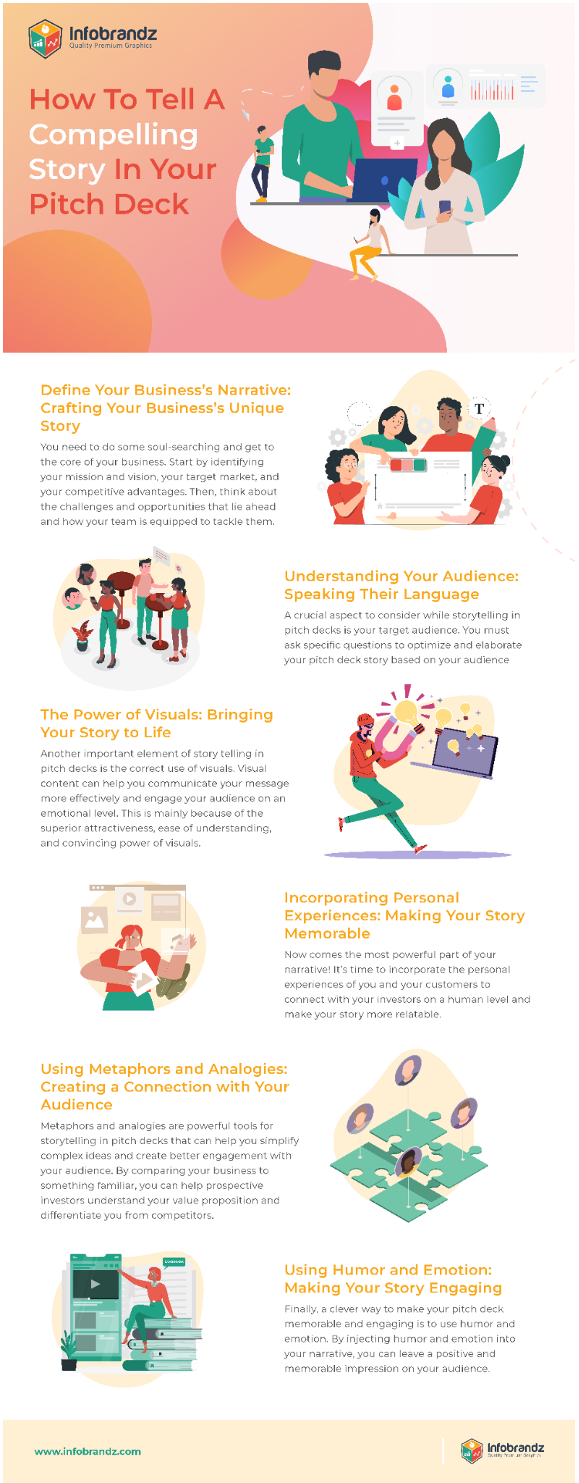You have an amazing business idea, a committed team, and a detailed financial plan. You put all of these into a pitch deck, complete with charts, graphs, and projections. But still, you’re struggling to convince investors to take a chance on your venture.
If you are facing this challenge, you’re not alone! 99% of pitch decks fail to convince investors, despite most being full of statistics. So, where do things go wrong?
The truth is; investors are not just interested in the numbers; they want to see the story behind them. They want to understand your vision, your passion, and your ability to execute your plan. And this is where the art of storytelling in pitch decks comes in. Keep reading to learn how to use storytelling to craft an investment deck that stands out and attracts investments.
How to tell a captivating story in your pitch deck?
By creating a narrative that resonates with your audience, you can capture their attention, create a connection, and ultimately persuade them to invest in your business. Let’s check the key aspects to understand how you can achieve this while avoiding common pitch deck mistakes.
Define Your Business’s Narrative: Crafting Your Business’s Unique Story
You first need to create a narrative about your business by first answering the key questions about your initiative-
- What is the story you want to tell?
- What makes your business and its offerings unique and interesting?
- What are the market opportunities, and how do you plan to reap them?
- What are the challenges and threats you face?
- How do you plan to overcome the challenges?
To answer such questions, you need to do some soul-searching and get to the core of your business. Start by identifying your mission and vision, your target market, and your competitive advantages. Then, think about the challenges and opportunities that lie ahead and how your team is equipped to tackle them.
Once you have the basic answers, you need to create the narrative as per a proven pitch deck structure. Let’s understand what you need to cover while creating it-
- Your pitch deck should start with a strong opening slide that captures your audience’s attention and sets the tone for your entire narrative. This could be a bold statement, a provocative question, or just a memorable visual that encapsulates your value proposition.
- From there, you should include slides that outline the problem you aim to solve, the solution you have come up with, and the unique selling propositions of your product or service. Use visuals, metaphors, and personal experiences wherever required to illustrate your story and further engage your audience.
- Next, you should include slides outlining your business model, market size, and financial projections. You can use charts, graphs, and other data visualizations to support your narrative and demonstrate the viability of your business.
- End your investment deck with a strong closing slide that summarizes your key points and leaves a lasting impression on your audience. This could be a call to action, a memorable quote, or a catchy visual that reflects your vision for the future.
- Make sure to make your narrative compelling, memorable, and easily understandable. It should reflect your values and personality as a founder in an authentic and engaging manner.
Once you have made the narrative for your business, you can now proceed to create a storyline from this narrative by incorporating the various aspects of storytelling in pitch decks. Let’s discuss these aspects now to create an impactful pitch deck story.
Understanding Your Audience: Speaking Their Language
A crucial aspect to consider while storytelling in pitch decks is your target audience. You must ask specific questions to optimize and elaborate your pitch deck story based on your audience. Some key questions are-
- Who are the investors you’re trying to reach?
- What are their interests, values, and objectives?
- What are their needs and pain points, and how can you address them?
This understanding will help you tailor your storytelling to the specific needs and preferences of the investors in your audience. For example, if your audience is composed of socially responsible investors, you should highlight the positive impact your business has on society. If your audience is more financially focused, you may rather emphasize the potential return on investment.
The key is to speak the language of your prospective investors and show them how your business aligns with their values and goals. This will help you create a personal connection and effectively present what’s in it for them, and this is crucial to convincing investors.
The Power of Visuals: Bringing Your Story to Life
Another important element of storytelling in pitch decks is the correct use of visuals. Visual content can help you communicate your message more effectively and engage your audience on an emotional level. This is mainly because of the superior attractiveness, ease of understanding, and convincing power of visuals.
So, think about the visuals you can use to support your narrative while creating the presentation. This may include images, videos, infographics, or animations. Make sure that these visuals are contextual, high-definition, and easy to understand.
Incorporating Personal Experiences: Making Your Story Memorable
Now comes the most powerful part of your narrative! It’s time to incorporate the personal experiences of you and your customers to connect with your investors on a human level and make your story more relatable.
For example, you may want to share your personal journey as a founder, including the challenges and setbacks you faced along the way. You may also want to highlight the experiences of your team members and how they contribute to the success of your business.
By sharing such personal experiences, you can demonstrate your resilience, passion, and commitment to your vision. Similarly, sharing case studies or customer testimonials will add credibility to your claims while making the pitch more interesting.
Using Metaphors and Analogies: Creating a Connection with Your Audience
Metaphors and analogies are powerful tools for storytelling in pitch decks that can help you simplify complex ideas and create better engagement with your audience. By comparing your business to something familiar, you can help prospective investors understand your value proposition and differentiate you from competitors.
For example, you may want to compare your business to a well-known brand or product, such as “The Amazon for freelancer services.” Alternatively, you can use metaphors to describe the benefits of your product or service in a more vivid and engaging way. For instance, you may describe your product based on a metaphor for its characteristics, like “RedBull gives you wings.”
The trick is to use metaphors and analogies that are simple, relevant, and memorable. This will help you create a connection with your audience and make your pitch deck more impactful.
Using Humor and Emotion: Making Your Story Engaging
Finally, a clever way to make your pitch deck memorable and engaging is to use humor and emotion. By injecting humor and emotion into your narrative, you can leave a positive and memorable impression on your audience.
For example, you may use a humorous anecdote to illustrate a point or lighten the mood. Similarly, you can use emotional language for storytelling in pitch decks in order to convey the passion and excitement you have for your business. Remember to use humor and emotion in a way that is appropriate and relevant to your narrative, as you don’t want to come across as insincere or unprofessional.
Case Study: Airbnb
https://www.slideshare.net/PitchDeckCoach/airbnb-first-pitch-deck-editable
Airbnb’s pitch deck is a great example of a pitch deck that tells an interesting and convincing story to hook investors and achieve their investments. The deck starts with a simple statement: “Airbed and breakfast.”
From there, it describes the problem the founders were trying to solve (i.e., the high cost of hotels during conferences), the solution they came up with (i.e., renting out airbeds in their apartment), and the results they achieved (i.e., building a global community of hosts and guests).
Airbnb’s pitch deck follows a simple, clear, and engaging storyline and backs it with convincing statistics. It also reflects the founders’ passion and creativity to show their commitment to the venture.
Summing up: The Art of Storytelling in Pitch Decks
In conclusion, storytelling in pitch decks is a powerful tool for entrepreneurs who want to persuade investors and stand out from the rest. By defining your narrative, understanding your audience, using visuals, incorporating personal experiences, using metaphors and analogies, and using humor and emotion, you can create a pitch deck that captures investors’ attention and inspires them to invest in your vision.
Remember, investors are not just interested in the numbers; they want to see the story behind them. So, take the time to craft a compelling story that reflects your values, personality, and vision. And don’t be afraid to be creative, passionate, and authentic. With the right story, you can turn your pitch deck into a powerful tool for success.
If you need any help in creating the perfect narrative and crafting a spectacular pitch deck, just contact us at Infobrandz. Our experts will understand your business, market, and prospective investors closely and then make a customized and compelling pitch deck quickly and affordably.












0 Comments